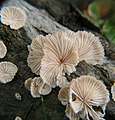Schizophyllum commune
| Schizophyllum commune | |
|---|---|
_(33389628036).jpg) | |
| Scientific classification | |
| Kingdom: | Fungi |
| Division: | Basidiomycota |
| Class: | Agaricomycetes |
| Order: | Agaricales |
| Family: | Schizophyllaceae |
| Genus: | Schizophyllum |
| Species: | S. commune |
| Binomial name | |
| Schizophyllum commune Fries (1815) | |
| Synonyms | |
| |
Schizophyllum commune is a species of fungus in the genus Schizophyllum. The mushroom resembles undulating waves of tightly packed corals or loose chinese fan. "Gillies" or Split Gills vary from creamy yellow to pale white in colour. The cap is small, 1-4.5 cm wide with a dense yet spongey body texture. It is known as the split-gill mushroom because of the unique longitudinally divided nature of the gill producing basidospores, which often splits when they dry out and moistened into gills as they shed into spores. It is the only known fungi capable of retracting by movement. This mushroom is found predominantly in Myanmar, Thailand, Malaysia, Indonesia, Madagascar, Nigeria and Northeastern India. It is found in the wild on decaying trees after rainy seasons followed by dry spells where the mushrooms are naturally collected. it is known for its high medicinal value and aromatic taste profile. It has recently attracted the medicinal industry for its immunomodulatory, antifungal, antineoplastic and antiviral activities that are higher than those of any other glucan complex carbohydrate.
Description
It was initially described as a morphological species of global distribution and then revealed to be a species complex encompassing several cryptic species of more narrow distribution, as typical of many mushroom-forming Basidiomycota.[1]
The gills, which produce basidiospores on their surface, split when the mushroom dries out, earning this mushroom the common name split gill. It is common in rotting wood, but can also cause disease in humans.[2][3]
It has 23,328 distinct sexes, properly called mating types.[4] Individuals of any sex are compatible for mating with all but their own sex. However, there are two genetic loci determining the mating type, locus A with 288 alleles and locus B with 81 alleles. A pair of fungi will only be fertile if they have different A and different B alleles;[5] that is, each sex can enter fertile pairings with 22,960 others.
Hydrophobin was first isolated from Schizophyllum commune.
Genetics
The genome of Schizophyllum commune was sequenced in 2010.[6]
Culinary
Although European and US guidebooks list it as inedible, this is apparently due to differing standards of taste rather than known toxicity, being regarded with little culinary interest due to its tough texture. S. commune is, in fact, edible and widely consumed in Mexico and elsewhere in the tropics.[7] And in North-East India, the state Manipur called it as "Kanglayen'" and it is one of the favourite ingredients for Manipuri-Pancake Style called "Paaknam". In Mizoram, the local name is "Pasi" (pa means mushroom,si means tiny) and it is one of the highest rated edible mushrooms among the Mizo community. The authors explain the preference for tough, rubbery mushrooms in the tropics as a consequence of the fact that tender, fleshy mushrooms quickly rot in the hot humid conditions there, making their marketing problematic.
Supplemental Images
 Schizophyllum commune Elk Grove, IL
Schizophyllum commune Elk Grove, IL
 Schizophyllum commune Grand Rapids, MI
Schizophyllum commune Grand Rapids, MI Schizophyllum commune in Estonia
Schizophyllum commune in Estonia
References
- ↑ Taylor, John; Turner, Elizabeth; Townsend, Jeffrey; Dettman, Jeremy; Jacobson, David (2006). "Eukaryotic microbes, species recognition and the geographic limits of species: examples from the kingdom Fungi". Phil. Trans. R. Soc. B. 361: 1947–1963. doi:10.1098/rstb.2006.1923. PMC 1764934.
- ↑ Guarro, J; Genéj; Stchigel, Am (Jul 1999), "Developments in Fungal Taxonomy" (Free full text), Clinical Microbiology Reviews, 12 (3): 454–500, ISSN 0893-8512, PMC 100249, PMID 10398676
- ↑ Chowdhary A, Kathuria S, Agarwal K, Meis JF. Recognizing filamentous basidiomycetes as agents of human disease: A review. Med Mycol. 2014 Nov;52(8):782-97. doi: 10.1093/mmy/myu047. PMID 25202126
- ↑ Raper, J.R., 1966. Genetics of sexuality in higher fungi. Genetics of sexuality in higher fungi.
- ↑ Kothe, Erika (1996). "Tetrapolar fungal mating types: Sexes by the thousands". FEMS Microbiology Reviews. 18: 65–87.
- ↑ Robin A Ohm,; De Jong, JF; Lugones, LG; Aerts, A; Kothe, E; Stajich, JE; De Vries, RP; Record, E; et al. (Jul 2010), "Genome sequence of the model mushroom Schizophyllum commune", Nature Biotechnology, 28 (9): 957–63, doi:10.1038/nbt.1643, PMID 20622885
- ↑ Ruán-Soto, F.; Garibay-Orijel, R.; Cifuentes, J. (2006). "Process and dynamics of traditional selling of wild edible mushrooms in tropical Mexico". Journal of Ethnobiology and Ethnomedicine. 2 (1): 3. doi:10.1186/1746-4269-2-3.
External links


- "Schizophyllum commune", MykoWeb
- "Tom Volk's Fungus of the Month for February 2000